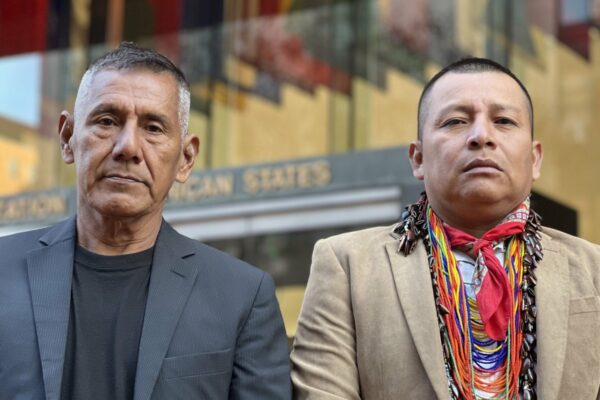
The Brazilian government’s planned dam projects in the Tapajós River basin mobilized the city of Santarém, in the eastern Amazon state of Pará, for more than seven hours of public discussion on January 29th at the headquarters of the city’s Commercial Association. Promoted by the office of Brazil’s Federal Public Prosecutors (MFP – Ministério Público Federal), the hearing convened more than 500 people to hear researchers, indigenous leaders, federal lawyers and leaders from traditional river communities. They addressed the innumerable risks and failings of planned Tapajós dam projects, which would gravely impact one of the most important ecological corridors in the Amazon as well as one of the most ancient areas of human settlement in the region.
So many people attended the hearing that in the beginning one group that couldn’t manage to enter the public auditorium provoked a bit of a ruckus in response to the attempt to cancel or change the location of the hearing. Even with the delay of about an hour, the debates went on normally. Representatives of various federal bodies were invited, but none of them showed up. “Of nine businesses that are stakeholders in the construction of the São Luiz do Tapajós Dam, eight are companies that are under investigation in the Lava Jato corruption case,” said prosecutor Camões Boaventura, to began his explanation of the irregularities identified by the MPF surrounding the Tapajos dam projects.
In all, there are 43 dams of various sizes projected by the government for construction on the Tapajós River and its three tributaries: Teles Pires, Juruena and Jamanxim. Some of them, on the Teles Pires and the Juruena rivers, are already under construction. On the Tapajós River, the government announced its intention to license the São Luiz do Tapajós dam in 2016, which would flood an indigenous Munduruku territory and several riverine communities. This project has already encountered at least four judicial challenges. One of them, charging that the project had not respected local peoples’ right to free, prior and informed consultation (FPIC), required under Convention 169 of the International Labor Organization (ILO169), has already received a ruling by Brazil’s Superior Justice Court that obliges the government to conduct such a consultation with these communities. Yet even after announcing its intention to license [São Luiz do Tapajós] in the coming months, the government has made no moves or preparations to consult peoples to be threatened by the dam.
“We want to be consulted,” said Ageu Pereira, leader of the riverbank community called Montanha e Mangabal. On the Tapajós River, the riverbank community residents call themselves “shore people,” or “riverbank people” – “beiradeiros” in Portuguese. As the name indicates, the banks of the river are essential for their way of life. If the hydroelectric dams are built, these people will no longer be riverbank people. Should the hydroelectric dam be built, the researcher Camila Jericó-Daminello estimated more than R$ 1 billion in revenue losses for riverbank communities, when calculating only in terms of the loss of forest products and fishing activities upon which today they now sustain themselves.
Pimental is another riverine community that has existed for centuries on the Tapajós River. Should the dam be built, it will disappear from the map. “We have already been impacted by this disrespect. The researchers for the dam come on our land and want to conduct their studies by force. If we don’t want them to do so, they call in troops from the National Security Force (Força Nacional) to make us comply. You can’t imagine how idiotic this is,” said Pimental leader José Odair Cak.
In addition to the use of force against the dam-threatened populations during the period of impact studies, and the total absence of the obligatory prior consultation of residents, the population in the region questions the necessity of the hydroelectric dams, for they understand that the energy generated will not benefit the Amazonian population. One of the debaters, Professor Célio Bermann, of the Universidade de São Paulo (USP), was categorical: “I affirm now that Brazil does not need hydroelectric dams on the Tapajos.” His statement was greeted by lengthy applause.
“We live in an electricity-dependent civilization. It’s true that we need electric energy. But hydroelectricity is not the only option. Our country has the highest energy costs in the world, with 70% coming from hydroelectricity. So we need to think seriously if this option is even correct,” said Bermann. “Each new plant is presented by the government as a solution for the threat of blackouts. That’s not the truth. What’s more, electricity blackouts are most often caused by a failure to maintain the Brazil’s electricity matrix, more than a lack of dams. Alternatives exist and these do not include gigantic hydroelectric dams in the Amazon. Yet the government does not consider the MPF and independent researchers in their electricity planning. This needs to change.”
During the hearing Ricardo Baitelo from Greenpeace also demanded that society participate in the planning of Brazil’s electrical matrix. He presented models under which Brazil may significantly increase installed energy supply without the construction of a single dam in the Amazon basin, with diversification of the energy matrix and investments in improved energy efficiency. “With these steps, it would definitely be possible to store wind energy.”
Even with so many alternatives presented, the researcher Phillip Fearnside, one of the most important specialists in tropical dams, made a sober alert that the government predicts a total of 69 large dams in the Amazon basin, varying between the size of the São Luiz do Tapajós to the Teles Pires dams, while flooding a total of 10 million hectares (more than 38,600 square miles).
The biggest stakeholders – those who live on the rivers and in the forests in the region – understand the profound consequences of this model. The General Chief of the Munduruku indigenous people explained with economy of words: “Not only the Munduruku are going to suffer; the whole world is going to suffer. We are defending the Brazilian people,” he said, speaking of their resistance against the dams. Researchers who spoke during the hearing agreed with the chief, affirming that damage to the Tapajos could harm not only the Amazonian region, but Brazil as a whole, and have worldwide impacts, taking into consideration that the Amazon basin functions as a worldwide regulator of climate. For example, the basin’s moisture ensures the delivery of humidity – and thus, rain – to São Paulo. Without the forest, researchers signaled, Brazil’s largest city would be a desert.
The forest is severely threatened by these projects. Ane Alencar, of the Institute for Environmental Research in the Amazon (Instituto de Pesquisa Ambiental da Amazônia, or IPAM), modeled rates of deforestation caused by the construction of Belo Monte Dam to project the deforestation that she predicts the hydroelectric dams will cause in the Tapajós River basin. She calculates a potential loss of more than 3.2 million hectares of forests in the area (12,400 square miles).
Methylmercury
One of the hearing’s presentations that had the most impact on the audience came from the doctor Erik Jennings, who warned of the risk of a human health catastrophe in the region. This would be caused by the potential of the dam reservoirs to transform themselves into veritable factories of methylmercury, which is extremely toxic and causes damage to the central nervous system, in addition to causing fetal malformations. Jennings said, “The Amazonian soil is rich in mercury, in its inert form, but with the formation of lakes from the hydroelectric dams, this mercury will assume a toxic form and will be absorbed by the fish, the principal source of food for the population in the region.”
Jennings mentioned a study done on women with long hair in the region of the installation of the Balbina dam in Amazonas State. Measuring the concentration of mercury up and down the length of the hairs, the researchers succeeded in proving that when the dam was installed, there was an explosion in the concentration of mercury in the women’s bodies.
“Why isn’t this topic covered in our research studies? We have a false sense of not being poisoned in the Amazon basin. In Minamata (a region in Japan where there were grave cases of mercury contamination), they needed 24 years in order to recognize the contamination, because the effects of mercury require a long cycle to manifest. We can’t sit and wait until this occurs in Amazônia,” said the doctor. The dam’s research studies of have dismissed the risk of mercury contamination, but they conducted exams only in the water and not on the fish, which is how mercury is absorbed by people.”
Archeological Heritage
Professors from the Universidade Federal do Oeste do Pará, Bruna Rocha and Raoni Valle, presented millennial human occupation in the Tapajós region. Rocha demonstrated the dated government narrative of Amazônia as a virgin forest. She showed examples of this rhetoric from the military dictatorship and a much more recent speech of Maurício Tolmasquim, president of Brazil’s Energy Research Compmany (EPE), who said that he believed that hydroelectric dams on the Tapajós River would not cause any impacts because people don’t live in the region.
“Archeology shows that the Tapajós region has been populated for over a thousand years. Archeological sites show human occupation dated from the 9th and 10th centuries A.D. in areas slated to be destroyed by the dams,” said Bruna Rocha. Raoni Valle, who is developing a research study in collaboration with the Munduruku people, reiterated the importance of protecting their sacred locations as a fundamental step to assuring the physical and cultural survival of indigenous peoples, in accordance with a United Nations resolution.
“The expropriation of the territory of these populations is the expropriation of their memories, because these memories are ingrained in their sacred locations, in the landscapes of the Tapajós. To destroy this region is to destroy the identity of these peoples who have woven their roots into it for so many centuries,” said Bruna Rocha.
Belo Monte
The Belo Monte hydroelectric dam, which is nearing completion on the Xingu River, around 621 miles from Santarém, was also a subject of the public hearing. Federal prosecutor Thais Santi, who acts on behalf of the MPF in Altamira, made a speech alerting the audience to the situation that the residents of the Xingu River are experiencing. “The construction of Belo Monte was accepted with the promise and commitment of the State in the region. After these promises, the State went away, and who has assumed the project is an enterprise that not only doesn’t have any prior knowledge of the region, but also deliberately did not fulfill its obligations. These agreed-to conditions [on the licensing of the dam] are an obligation. They are prerequisites for the viability of the project. Don’t let yourself believe in false promises,” she urged the audience.
Marcelo Salazar, from the Socio-Environmental Institute (Instituto Socioambiental – ISA), detailed the myriad of unfulfilled conditions of Belo Monte. “They built the largest engineering project in the world, and until now they were not capable of building even one functional hospital in Altamira. It’s pure contempt,” he affirmed. “On the Xingu River, [the federal indigenous agency] FUNAI has nearly shut its doors. There has never been an [federal environmental agency] IBAMA office in the Belo Monte region. The State has abandoned this population,” said Thais Santi.
Translated by Tiffany Higgins













